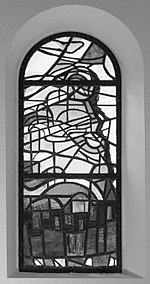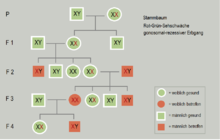Red-green poor eyesight
| Classification according to ICD-10 | |
|---|---|
| H53.5 | Color vision disorders - red-green weakness |
| ICD-10 online (WHO version 2019) | |

The terms red-green weak eyesight and red-green blindness stand for certain hereditary color ametropia . These are disorders of color perception , with those affected being less able to distinguish between the colors red and green than people with normal vision . A green weakness occurs much more frequently than a red weakness. In addition, significantly more men are affected. The medical terms for this are deuteranomaly or deuteranopia for green weakness and green blindness, as well as protanomaly and protanopia for the corresponding red disorder.
frequency
About 9% of all men and about 0.8% of women are affected by red-green weak eyesight or blindness, so it is significantly more common than yellow-blue weak eyesight or blindness ( tritanopia ) or complete color blindness , both of which only occur with a probability of 1: 100,000.
causes
The X-linked recessive visual impairment is caused by changes in the amino acid sequence in the visual pigment proteins ( opsin ) of the corresponding cones of the retina , which result from the change in the gene sequence of the corresponding opsin. Every human being has one gene for red-sensitive opsin and three identical genes for green-sensitive opsin. They are all close together on the X chromosome . If the gene for one of these opsins is missing, one speaks of red or green blindness (protanopia or deuteranopia). Red-green poor eyesight or blindness is always innate and does not worsen or decrease over time.
Protanopia is the technical term for red blindness (red cone missing), protanomaly for red vision deficiency (red cone degenerated), deuteranopia for green blindness (green cone missing), deuteranomaly for green weakness, the most common type of colloquially called color blindness. Blue cone monochromatism represents a special case of red-green blindness, here red and green cones are completely absent, only the blue cone is present.
In addition, there is sometimes total color blindness, i.e. the uncoloured world in achromatopsia .
Passing on of red / green poor eyesight or blindness

This form of poor eyesight is hereditary; That is, it is passed on through parental genes. The reason why it is about ten times as common in men as in women is that the ability to distinguish these colors is passed on through the 23rd chromosome , the X chromosome , and that the defect is a recessive trait. If chromosomes are present in pairs and if a characteristic is different on both chromosomes, the dominant characteristic covers the recessive one, which is therefore not phenotypically noticeable ( X-linked inheritance ).
The 23rd chromosome also determines gender in humans. As a rule, women have two X chromosomes, while men have one X chromosome and one Y chromosome instead . So if a woman has an X chromosome that does not contain the genetic information that makes it possible to differentiate between the colors, the second X chromosome still enables her to do this because it covers the defect. However, she can pass on the recessive hereditary disposition and is therefore a carrier . For a woman to suffer from the red-green color weakness, both X chromosomes must have the defect. In men, however, there is usually no second X chromosome to compensate for the defect.
The connection with the X or Y chromosome, which determines the gender, results in an almost unique possibility of making the passing on of the defect or the passing on of characteristics from parents to their children visible on the basis of a family tree analysis . Father and mother each pass one of the two pairs of chromosomes on to their child. Since the 23rd chromosome determines the sex, the father decides on the sex of the child. If he passes on his Y chromosome, the child becomes male, since the mother gives it an X chromosome. If the father passes on the X chromosome, the child receives two X chromosomes and thus becomes female. This results in the following rules, which - apart from mutations - always apply :
- If neither father nor mother have red-green visual impairment, the genetic defect can “hide” in one of the two maternal X chromosomes. Consequently, in this constellation none of the daughters will be affected by the visual impairment, but sons will be affected if they receive the one of the two maternal X chromosomes with hidden defects.
- If the father has red-green visual impairment, but the mother has two X chromosomes without the defect, no child will suffer from the visual impairment. However, all daughters have a hidden X chromosome with the defect. They are therefore carriers, which results in a 50 percent risk for male grandchildren.
- If the mother has poor eyesight, both X chromosomes have the defect. Consequently, all sons have the defect and all daughters are at least carriers of the characteristic. Whether the poor eyesight also occurs in them depends on whether the father is also affected.
- If the father has poor eyesight and the mother carries an X chromosome with the defect, the son and daughter may be affected. That depends on whether the mother passes the gene on. But the daughter will definitely be the carrier of the gene inherited from her father.
Red-green poor eyesight in everyday life
The poor eyesight is generally not seen as a problem by those affected. Countless experiments, for example with pattern-induced flicker colors, also suggest that people with color deficiencies - apart from the lower ability to differentiate between colors in the areas of their disorder - develop the same aesthetic impression of colors ( color wheel , color aesthetics ) as people with normal vision (see also tetrachromates ). However, some professions such as train driver , bus and taxi driver , pilot or police officer may only be practiced after successful extensive and special ophthalmological examinations (anomaloscope, lantern test ). The same applies to some air or water sports due to the importance of the colors red and green to differentiate between port and starboard. The habit of game manufacturers to often use the colors red and green for game pieces makes it harder for those affected to differentiate.
This hurdle is often not considered in publications, especially in the web , which is more colorful than the print media . It is particularly important for thin lines and small elements. A red (often dark red) word highlighted in black letters in a text is not recognized as highlighting by those concerned. Highlighting in blue, on the other hand, is usually easy to see.
Thematic maps that work with different color nuances are often only partially legible for people with red-green visual impairment, on the other hand, more different shades of a color are often more easily perceived by them. In order to be able to unequivocally assign these different shades to the values of the legend, it is helpful if the legend can be moved in a separate window above the map and can thus be compared directly next to one another with a map element.
Since there are many mixed colors in everyday life, problems often arise when differentiating between colors that at first glance do not contain red or green. For example, with shades of blue mixed with green or red.
Problems can also arise when driving at night. However, the only problem here is the red weakness, as those affected only see the red light at a short distance. In the case of people with green weakness, on the other hand, the problem only occurs with green traffic lights, they can hardly distinguish them from street lights and advertisements at a great distance. In practice, however, this is irrelevant, since a green traffic light does not require any reaction. When driving a car during the day, people with weak green eyes can have problems with poorly designed construction site traffic lights: If the traffic lights have a round white advertisement of the same size under the green light and the red light is relatively weak at the same time, the green-blind can be seen from a greater distance in the sunshine possibly mistakenly mistaking the bright, round advertising sticker for green light and overlooking the red light.
Studies have shown that people with color deficiencies can distinguish a greater number of khaki tones than people with normal vision . This phenomenon is used by the military, because color ametropia people are not so easily fooled by camouflage colors and therefore more easily spy a camouflaged soldier in the forest than people with normal vision. This is due on the one hand to the above-mentioned phenomenon, and on the other hand to the fact that people with color vision deficiencies have learned in the course of their lives to concentrate more on shapes and contours than on colors like those with normal vision.
It is assumed that in addition to a malfunction of the cones, their number on the retina is also lower. As a result, people with color deficiencies would have more rods that are responsible for twilight vision , which would explain why people with color deficiencies have better scotopic vision than those with normal vision .
Investigation methods
The severity of red-green visual impairment can be determined with color charts (for example the Ishihara color charts shown here ), more precisely with the so-called Farnsworth test or with an anomaloscope . The “Lantern test” is recognized as a further test method, for which there are again three different test devices (Holmes-Wright Lantern, Beyne Lantern and Spectrolux Lantern).
Simulation of red-green visual impairment for trichromats
Red-green visual impairment can be simulated for trichromats ( color-sighted people with three types of cones ) by combining the red and green color channels of a digital image into a yellow channel in which red and green have the same brightness. In the following overview some examples of this and the corresponding grayscale images have been added to simulate achromatism, in which no colors can be recognized.
| motive | Trichromatic image | Dichromatic picture without red-green distinction |
Achromatic image in grayscale |
|---|---|---|---|
| Pseudoisochromatic color chart |

|

|

|
| Fruit stand |

|

|

|
| Stained glass window |

|

|

|
| Rainbow |

|

|

|
Individual evidence
- ↑ Th. Axenfeld (conception), H. Pau (ed.): Textbook and atlas of ophthalmology. With the collaboration of R. Sachsenweger and others Gustav Fischer Verlag, Stuttgart 1980, ISBN 3-437-00255-4 , p. 59.
- ^ Fritz Hollwich, Bärbel Verbeck: Ophthalmology for nursing professions. 2nd Edition. Georg Thieme Verlag, 1980, ISBN 3-13-500402-3 .
- ↑ Retina Science. Retrieved September 13, 2015 .
- ↑ Orphanet, The Portal for Rare Diseases and Orphan Drugs. Retrieved September 13, 2015 .
- ↑ Multidimensional scaling reveals a color dimension unique to 'color-deficient' observers. Robinson, Jordan & Mollen, Boston 2005.
literature
- Franz Grehn: Ophthalmology. 30th edition. Springer Verlag, Berlin 2008, ISBN 978-3-540-75264-6 .
- Wolfgang Hammerstein, Walter Lisch: Ophthalmological Genetics. Enke Verlag, Stuttgart 1985, ISBN 3-432-94941-3 .
- Rudolf Sachsenweger: Neuroophthalmology. 3. Edition. Thieme Verlag, Stuttgart 1983, ISBN 3-13-531003-5 .


